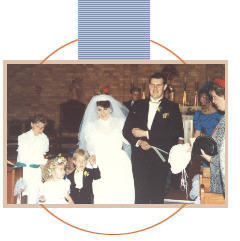



|
|
Overview |
|

![]()
Human Personal Encounter
and the Sacred
"The closer the embrace, the sweeter
the kiss."
Mechthild of Magdeburg.
Friendship is a critical part of life's journey for every human person. Each of us has an essential need of significant other people in our lives. The quest for love is an on-going, maturing, growth element of each of our lives. The quest never ends.
Seeing sacramentality broadly as that which gives new meaning to our human experience we can start with human friendship as the basis of our Christian sacramental system.
The meaning that Jesus and the Church give to friendship speaks of human love as sacred, as an expression of God's love in the world. So, in committed friendship there is a new opportunity for grace, a chance to experience God.
This has not always been fully appreciated or expressed by the Church.
In fact, there has been, even in our recent past, a negation of the sacredness of relationship and sexuality that has done violence to Christian friendship and love. Such attitudes even placed the married state far below that of consecrated virginity. This attitude, thankfully, is shifting as people see choice as a matter of personal vocation. Yet change is slow and many still find it difficult to integrate their love life into their spiritual journey without a great deal of inner conflict.
When young people come to formally prepare for Marriage, as a starting point, I encourage them, to speak of their experience of love. They tell me how they met, how good it is, how consuming, how vibrant. Into that experience I ask the question ‘Why marry?’ To many it is a surprise and the answer proves hard to put into words adequately. However, common to all responses are two things - they are marrying for love and they want to commit themselves to one another. Love and Commitment are what it seems to be about.
In reply to my further question ‘why marry in a religious ceremony?’, responses arise, often after answers that refer to family expectations, that speak of it seeming to be the ‘right’ place and way to go about it.
Exploring this further with some Christian perspective like ‘God is Love and anyone who lives in love lives in God, and God lives in that person’
(1 Jn 4:16) can often bring about a revelation that really moves a young couple. They discover and name for the first time that they ‘know God’ in their love for one another, that they have an experience of the Sacred through their relationship. In fact, they have often sensed this dimension in their relationship, but this revelation helps them to name what they have in their love. They discover their God and their love in a new way. They name grace.
Jesus' perspective on love is summed up in his greatest commandment with its two aspects, love God and love of Neighbour, inextricably bound together. This revelation about love was so powerful for the early Christians that they concluded that the self-giving of two people manifests the relationship between Jesus and the Church (Ephesians 5). Marriage shows forth, ‘sacramentalises’, the relationship between humanity and God.
The Jewish Scriptures began to speak of this meaning of relationship in the great covenant agreement statement ‘I will be your God, you will be my people’. There are a number of such covenants in the Old Testament between God and the People - between God and Noah, Abraham, Moses. They all express the agreement, the commitment of both parties to fidelity and love.
We read in the prophecy of Hosea that his own experience of his difficult marriage with Gomer became a sign of God's forgiveness and faithful, abiding, healing love. From Hosea's time the marriage relationship was used to help the people understand their relationship with God on a more personal level. The love relationship stood alongside the king/subject relationship and the shepherd/sheep that had been the main images used previously.
These writings and especially the great love poem, the ‘Song of Songs’, not only changed the people's understanding of their relationship with God but also expressed new meaning for human relationships.
This revelation comes to a fullness in Jesus. In the saving event of Jesus we see God's great act of faithful, healing love in a life given for us. Jesus is saying ‘Here, this is my life for you’. This is the great Covenant sealed in blood. He symbolised this in the Eucharist – ‘This is my body, given for you’, ‘This is my blood, given so that sins may be forgiven’, ‘Do this in memory of me’. The Spirit inspires us to live in memory of this love.
In this ‘history of salvation’ we see God communicating with the People of faith. Communication becomes the critical factor in this relationship between God and the People. At the same time, marriage and friendship are seen as revealing, communicating, God. The sacramentality of friendship and marriage is established.
Communication is indispensable in the growth and process of relationship. Such communication in Christian marriage is meant to include faith in the grace that comes through Jesus and his saving events of his life, death and resurrection.
The Marriage Rites communicates this rich tradition and meaning through various symbols.
- The people who gather are those who have been part of the love journey of the couple, those who have communicated as ‘sacraments of love’ to them;
- The Word of God proclaimed communicates the context of this love joined to the meaning of Jesus;
- The joining of hands communicates the ‘laying on of hands’, calling down the Spirit to give a new meaning to this relationship;
- The words of love and commitment that the couple speaks to one another is spoken in memory of the Jesus love;
- where a couple choose to celebrate their marriage with a Eucharist, the one Bread and the one Cup seals the ceremony in a powerful way emphasising the unity of two individuals in marriage and the unity between the couple and the community;
- Various other cultural symbols can add to this - the giving of rings, the kiss, the crowning.
The couple become a sacrament of God's love in the world and their Christian family is called to be the basic example of love, of Christian community. This is the domestic Church.
Many people in our world live in pluralistic societies with diverse people of differing cultures, races, persuasions and faiths entering into "ecumenical" and "mixed faith" marriages. This can cause tension. On the other hand, these very couples, in their struggle to design a marriage ceremony and to live with respect for each other, can be very special ‘sacraments’ of reconciling, healing love in our world.
Another tension today is that when we speak of ‘family’ as the domestic church we are in danger of narrowing down reality. The smaller nuclear family - parents and a couple of children- is the reality rather than the large family and the geographically close, extended family. And a growing number of people experience single parent family life.
We need to broaden our understanding of family if we are to say that the family is the basic unit of Christian community. Small Christian communities made up of a few families that support one another, who pray together, who review their lives in the light of the Gospel, who live in friendship, can express the Gospel love that Jesus established with his apostles and disciples.
In all this, the basis of such a ‘family’ church or ‘small community church’, is still the love experience of the individuals involved. This includes even the experience of brokenness, and the journey of single people.
At the same time as we broaden our understanding of sacramentality and family in this chapter, we need to look to the deeper meaning of love.
A man driving along a country road one day was suprised to see a farmer ploughing his field using his Prize Bull to pull the plough. Fascinated, he stopped and asked the farmer what was wrong with his tractor. "The tractor is fine," replied the farmer, "I'm just trying to teach Ferdinand that there is more to life than romance".
Television soapies, novels, magazines, and popular music feed us full to overflowing with our diet of romantic love. The great ancient Celtic story ‘Tristan and Isolde’ is the beginning of such romantic stories that concentrates love on personal fulfillment. Romance has become equated with love in our times. Yet there is more to life and love, as Ferdinand learnt, than romance.
That ‘more’, for Christians, is especially found in the covenant love of Jesus, in his great act of love in dying and rising for the life and love of the world. He pointed us to something that would support, enhance and build on romantic love. Jesus was the sacrament of the ‘God love’. The God love of Jesus is expressed in the New Testament in two Greek words –‘Philos’ and ‘Agape’. ‘Philos’ love said ‘I want to be-friend you’. It calls for a lot of reconciliation and conversion. ‘Agape’ love that says "I am gift to you", "I am prepared to sacrifice for you, to give of my life unconditionally". Philos (friendship) and agape (sacrifice) speak of healing. Throughout his ministry Jesus used physical healing as a great sign of what the Reign of God, the Kingdom, was about. He asked us to live in memory of this great love shown in his dying and rising. He is Grace, the healing ‘gift’ of the Father's love in the power of the Spirit. He is intimate faithful ‘friend’, the God who proves ‘neighbour’ to us.
The Journey of meaning and discovery of God begins in this context of human love and friendship in which God is revealed as LOVE, especially in Marriage, and the Church, as such a community of love seeks to initiate others into its spirit and life.
Further Reading
Whitehead, James and Evelyn. " A Sense of Sexuality; Christian Love and Intimacy." Doubleday, New York. 1989
Pastoral Dimensions of relationship using modern behavioural sciences.
|
|
|
|


Copyright © Anthony Kain 2009